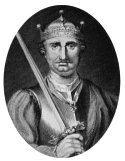When he was growing up , he always had to look over his shoulder. Many people wanted the throne and would do anything for it. This is why three of his guardians were murdered.
He married Matilda of Flanders, and they had four sons and six daughters (see list below).
He succeeded his father to the dukedom as a young boy in 1035 and was known as Duke William II of Normandy. He immediately came under attack from the vassals. With the assistance of King Henri I of France, William finally secured control of Normandy by defeating the rebel Norman barons at Caen the battle of Val-ès-Dunes in 1047.
Upon the death of William's cousin king Edward the Confessor of England (January 1066), William claimed the throne of England, asserting that the childless Edward had named him his heir during a visit by William (probably in 1052) and that Harold Godwinson, England's foremost magnate, had reportedly pledged his support while shipwrecked in Normandy (c. 1064). He made this pledge whilst in captivity and was reportedly tricked into swearing on a saint's bones that he would give the throne to William. Even if this story is true, however, Harold made the promise under duress and was so free to break it.
In order to pursue his claim, William invaded England on September 28 and defeated King Harold Godwinson at the Battle of Hastings (October 14, 1066), thus allowing him to seize the throne. This was the beginning of what is now known as the Norman Conquest. His victory is commemorated in the Bayeux Tapestry.
William initiated many major changes, amongst them a fundamental review of the prevailing Anglo-Saxon legal system, which he fused with Norman law. In 1085, in order to ascertain the extent of his dominion, William commissioned the compilation of the Domesday Book, a survey of England's productive capacity similar to a modern census. He also ordered the building of a number of castles, among them the Tower of London.
He died at the Convent of St. Gervais, near Rouen, France, on September 9, 1087 from injuries received when he fell off a horse at the Siege of Mantes. He is buried at St. Stephen's, Caen, Normandy, now in France.
William was succeeded in 1087 as king of England by his younger son William II and as duke of Normandy by his elder son Robert Curthose, who had earlier rebelled. His youngest son Henry also became king of England later, after William II died without any child to succeed him.
Children of William the Conqueror and Matilda of Flanders
Some doubt exists over how many daughters there were. Nonetheless, the list seems to be as follows:- Robert Curthose (~1054 - 1135), Duke of Normandy, married Sybil of Conversano, daughter of Geoffrey of Conversano
- Adelizia (or Alice)(1055- d. ~1065), reportedly betrothed to Harold II of England (existence in some doubt)
- Cecilia (~1056 - 1126), Abbess of Holy Trinity, Caen
- William Rufus (1056 - 1100), King of England
- Richard (1057 - ~1081), Duke of Bernay
- Adela (~1062 - 1138), married Stephen, Count of Blois
- Agatha (~1064 - ~1080), betrothed to (1) Harold of Wessex, (2) Alfonso VI of Castile
- Constance (~1066 - 1090), married Alan IV Fergent, Duke of Brittany
- Matilda
- Henry Beauclerc (1068 - 1135), King of England, married (1) Matilda (or Edith) of Scotland, daughter of Malcolm III, King of Scotland, (2) Adelicia of Louvain, daughter of Geoffrey of Louvain, Duke of Brabant
| Preceded by:
Edgar Ætheling |
List of British Monarchs | Succeeded by:
William II |
See: William the Conqueror by David Bates ISBN 0752419803
